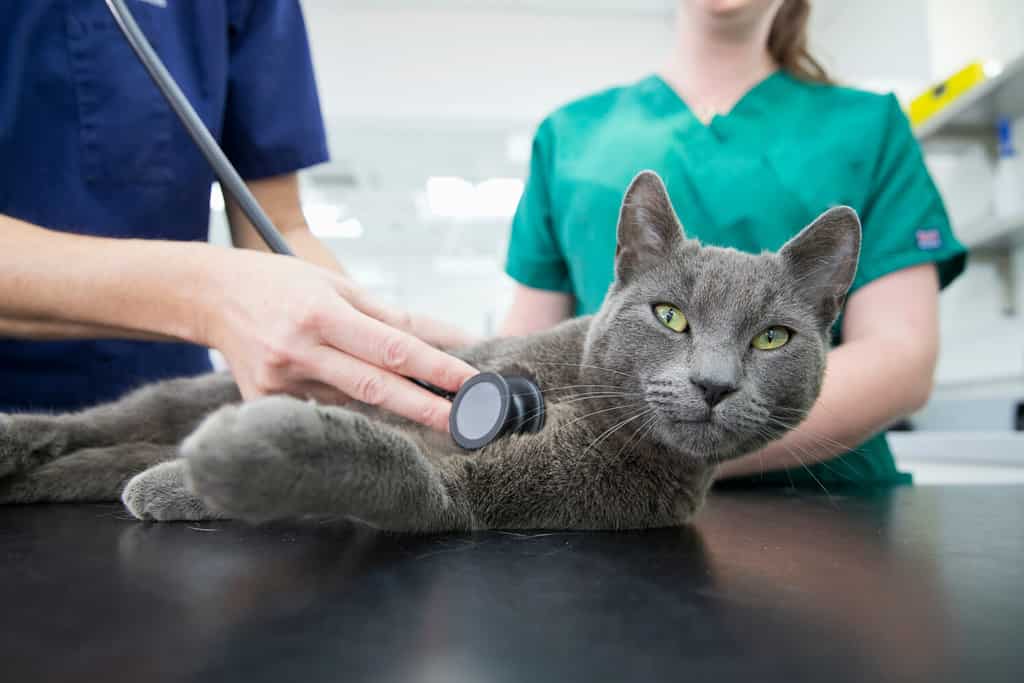Were you just cleaning your cat’s litter box, only to stumble upon rice-like worms wiggling around in their stool? We know this can be a daunting sight, and you likely want to get to the bottom of it quickly!
In this article we’ll answer the question of what these worms are, how cats get them, and how to banish them once and for all! Let’s get started.
Worms That Look Like Rice In Cat Poop – What Are They?

Tapeworms live in the digestive tract and related ducts of hosts.
©iStock.com/Artur Plawgo
If you stumble upon worms in your cat’s poop that look like grains of rice, then you are most likely looking at tapeworms! Tapeworms are flat, segmented parasites that are commonly found in cats and dogs. Unlike other intestinal parasites like hookworms and roundworms, the tapeworm belongs to the cestode family. The tapeworm is made up of multiple segments that each house a reproductive unit, meaning each segment of tapeworm can create more tapeworms.
Not only will you find these tapeworms in your cat’s stool, but you may also see them in the fur around your cat’s anus. These segments may also appear golden or tan as they harden, and many pet parents mistake the dried tape worms in their cat’s fur for litter. However, we encourage you to take a look at your cat’s stool is you are commonly finding debris around their anus. If they have tapeworms present near the anus, they are likely in their stool as well.
How Do Cats Get Tapeworms?
Fleas are responsible for infecting our feline friends with tapeworms. A cat just needs to ingest one infected flea to fall victim to a tapeworm infection, and this often occurs during the grooming process. As the flea is consumed and enters the cat’s digestive tract, the tapeworm egg will be released. The tapeworm egg will soon hatch and anchor itself to the intestinal lining, feeding on the nutrients in the gut as it completes its life cycle. The tapeworm will continue to reproduce until the cat is treated.
It’s important to note that your cat does not need to have a current flea burden to have tape worms. It can take a few months for tapeworms to become visible in your cat’s stool after infection, so even if your cat was recently treated for fleas, you may still find tapeworms in their stool up to 3 months later.
What Are The Signs & Symptoms Of Tapeworms In Cats?

Not only can you find tapeworms in your cat’s stool, but you may also see them in the fur around your cat’s anus.
©Juice Flair/Shutterstock.com
One of the most common signs of tapeworms in cats are visible worms in their stool, but there are other symptoms to be on the lookout for as well. Some of the most common signs of tapeworms in a cat include:
- Soft stool
- Diarrhea
- Vomiting
- Scooting their back end
- Weight loss
We always suggest reaching out to your veterinary team if you think your cat could have intestinal parasites.
How Do You Treat Tapeworms In Cats?
Thankfully for our feline companions with tapeworms, these intestinal parasites are easy to treat. Your vet can typically diagnose your cat with tapeworms by simply seeing the worms in their stool, but they may suggest performing a fecal sample for good measure. This test involves collecting a small sample of stool and examining it under a microscope to search for parasite eggs.
The most common treatment for tapeworms in cats is a medication called Drontal. Each Drontal tablet contains pyrantel and praziquantel, and both of these agents kill any living parasites within the digestive tract. Your vet will likely administer one tablet to your cat at their appointment, and then send you home with a second tablet to give two weeks later. This helps to ensure that all parasites were effectively killed.
Can People Get Tapeworms From Cats?
If your cat has just been diagnosed with tapeworms, then you may be worried about your health and safety. While it is possible for someone to become infected with the feline tapeworm, it is incredibly rare. You would need to ingest an infected flea to become infected with tapeworms, and this is not a common occurrence. Most of the reported cases of Dipylidium caninum tapeworm infections occur in children or immune compromised individuals living in unsanitary conditions.
Final Thoughts On Tapeworms In Cats
Tapeworms are an intestinal parasite that are commonly found in cats with fleas, or those who previously had fleas. Tapeworms are easy to diagnose and easy to treat, so most feline friends make a full recovery after treatment. Be sure to review the information above to better understand these strange parasites!
Thank you for reading! Have some feedback for us? Contact the AZ Animals editorial team.








